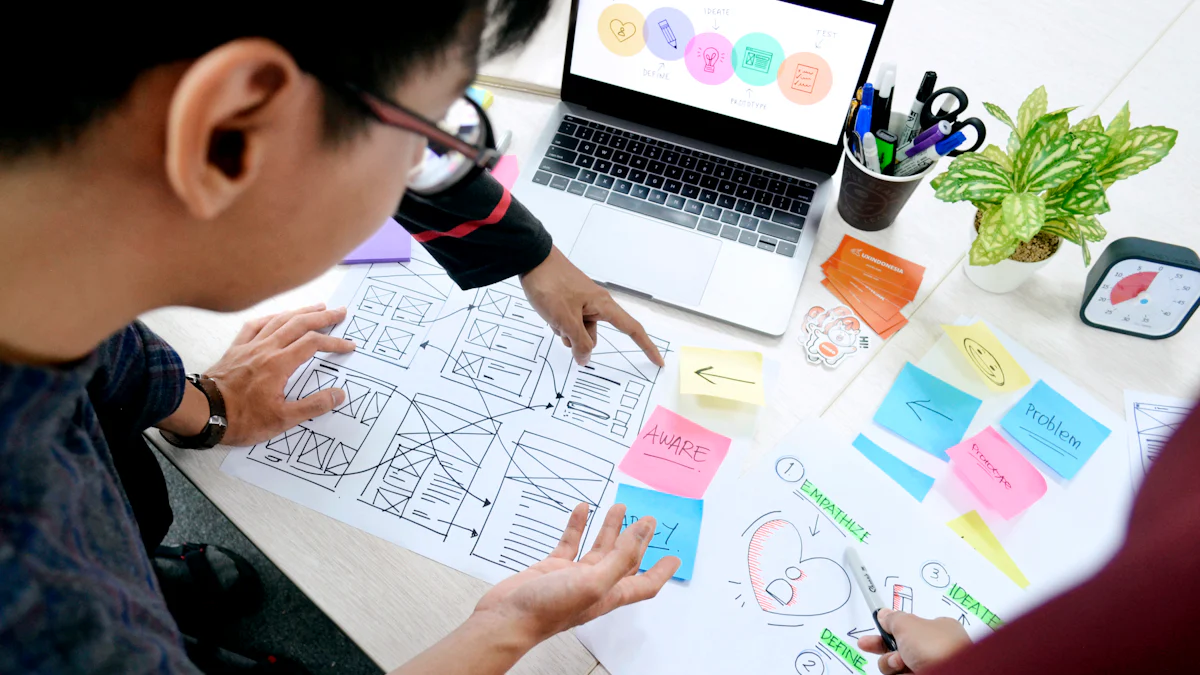Mastering Customer Development for Lean Startup Success in 2025

Customer development is the backbone of the customer development lean startup methodology. It helps you understand your audience and build products they truly need. But as we approach 2025, the business world is shifting fast. Companies face challenges like economic uncertainty, supply chain disruptions, and skills shortages. To thrive, you need to adapt quickly and stay ahead of these changes.
Delivering a standout customer experience is more important than ever. With AI and data analytics, you can uncover what your customers want and create personalized solutions. Tools like feature flags make this process even smoother, letting you test ideas and gather insights in real time. By embracing these strategies, you’ll stay competitive in a rapidly evolving market.
Key Takeaways
Customer development helps you learn about your audience. Build products they truly need by avoiding guesses.
Follow four steps: Discovery, Validation, Creation, and Company Building. These steps help you understand customers and plan your business.
Use live data to create customer profiles. Update them often to match changes in behavior and trends.
Use customer feedback to improve your product. Focus on feedback that solves big problems and fits your goals.
Use tools like AI and feature flags. These tools predict needs, study feedback, and test features safely.
Understanding Customer Development in Lean Startup

What is Customer Development?
Customer development is all about understanding your audience and building solutions that solve their real problems. It’s a systematic approach to learning about your customers, their needs, and how your product fits into their lives. Instead of assuming what your customers want, you test your ideas and gather feedback to guide your decisions. This process ensures you’re not wasting time or resources on features or products that don’t resonate.
In the lean startup methodology, customer development works hand-in-hand with product development. While product development focuses on building, customer development focuses on learning. Together, they create a cycle of continuous improvement, helping you deliver value faster and more effectively.
The Role of Customer Development in Lean Startup Methodology
Customer development is a cornerstone of the lean startup methodology. It helps you validate your ideas before scaling. By focusing on customer discovery and validation, you can avoid costly mistakes and ensure your product aligns with market demand. This approach emphasizes rapid learning and iteration, which are key to staying agile in today’s fast-paced business environment.
Companies like Dropbox and Zappos have used customer development to great success. Dropbox started with a simple screencast to test demand, while Zappos validated the idea of online shoe sales by selling inventory they didn’t yet own. These examples show how understanding your customers can lead to smarter decisions and better outcomes.
The Four Steps of Customer Development
Customer Discovery
This is where it all begins. You identify your target customers and validate their problems. Start by defining a hypothesis about the problem you’re solving. Then, test it by talking to potential customers. Create a prototype and gather feedback to see if your solution meets their needs. This step is all about discovery and learning.
Customer Validation
Once you’ve confirmed the problem, it’s time to test your solution. Does it effectively address the issue? Can you build a scalable sales model around it? This phase ensures your product has real demand before you invest heavily in development.
Customer Creation
Now, you focus on creating demand. Use marketing strategies to attract and engage your audience. This step is about turning your early adopters into loyal customers and building momentum for growth.
Company Building
Finally, you transition from learning to execution. Establish formal structures and processes to scale your business. At this stage, you’re no longer experimenting—you’re building a company that delivers consistent value.
Together, these four steps form a roadmap for success. They guide you from discovery to execution, ensuring every decision is rooted in customer insights.
Practical Strategies for Effective Customer Development
Dynamic Persona Creation
Using real-time data to refine customer personas
Creating accurate customer personas is essential for understanding your audience. But static personas can quickly become outdated. To keep them relevant, you should use real-time data. Start by conducting thorough research to identify your target customers. Gather demographic details, behavioral patterns, and preferences. Then, interview your customers to uncover deeper insights. Use this information to build templates that represent your ideal customer.
Once you have your personas, test them. A/B testing and analytics tools can help you validate their accuracy. For example, you might test different marketing messages to see which resonates most with your audience. Finally, refine your personas regularly. This ensures they evolve alongside your customers and the market.
Adapting personas to market changes
Markets change fast, and your personas should reflect that. Start by gathering new data to understand shifts in customer behavior. For instance, are your customers adopting new technologies or changing their buying habits? Align your personas with your business goals to ensure they stay relevant.
You should also audit your existing content. Identify what still works and what needs updating. Regular updates to your personas will help you address your customers’ evolving needs and uncover new opportunities for growth.
Conducting Effective Customer Interviews
Asking the right questions
Customer interviews are a cornerstone of customer discovery. To get actionable insights, you need to ask the right questions. Start by setting clear goals for your interviews. What do you want to learn? Write a guide with open-ended questions that encourage detailed responses. For example, instead of asking, “Do you like this feature?” ask, “How does this feature solve your problem?”
During the interview, focus on active listening. Pay attention to what your customers say and how they say it. This will help you uncover pain points and validate your assumptions.
Avoiding biases in customer feedback
Bias can distort your learning process. To avoid it, approach interviews with an open mind. Don’t lead your customers toward specific answers. For example, instead of asking, “Would you pay for this feature?” ask, “How do you currently solve this problem?”
Involve multiple team members in the interview process. Different perspectives can help you interpret feedback more objectively. Finally, analyze your data carefully. Look for patterns rather than focusing on individual opinions.
Leveraging Feedback for Iterative Improvement
Turning feedback into actionable insights
Feedback is only valuable if you act on it. Start by filtering out noise and focusing on the real problems your customers face. For example, one startup discovered that their primary users were frustrated with inconsistent processes. By addressing this issue, they created an MVP that significantly improved their metrics.
Spend time with your customers to understand their pain points. Use this information to make targeted improvements to your product. This approach aligns with the principles of validated learning and ensures your efforts deliver value.
Prioritizing feedback for product development
Not all feedback is equal. To prioritize effectively, assess its potential impact on your product. Focus on feedback that addresses critical pain points or offers a competitive advantage. Look for recurring themes to identify areas that need attention.
Be realistic about your resources. Prioritize changes that require minimal effort but provide significant value. Align your feedback with your product strategy to stay focused on achieving product market fit. This ensures your development efforts are both efficient and impactful.
Using Feature Flags for Lean Development
Reducing risk with feature toggles
Feature flags are a game-changer when it comes to reducing risk in software development. They let you control which parts of your code are active, even after deployment. This means you can release new features incrementally, keeping the rest of your system stable. If something goes wrong, you can quickly disable the feature without rolling back the entire deployment. This approach makes your releases safer and more predictable. By isolating new code, you can test it in real-world conditions without jeopardizing your product.
Accelerating feedback through controlled rollouts
Gathering feedback quickly is crucial when implementing lean startup principles. Feature flags make this easier by allowing you to roll out features to a small group of users first. You can monitor how they interact with the new functionality and collect real-time data. This controlled rollout helps you identify what works and what doesn’t before a full release. It’s like having a built-in testing lab where your users provide insights that guide your next steps.
Minimizing waste by validating features incrementally
Building a minimum viable product is all about efficiency. Feature flags align perfectly with this goal by letting you validate features one step at a time. Instead of investing heavily in a feature upfront, you can test its value with a smaller audience. If the feature doesn’t resonate, you can pivot without wasting resources. This incremental approach ensures you only scale what truly adds value, keeping your development lean and focused.
FeatBit: The Best Feature Flag Tool for Lean Startups
If you’re serious about mastering customer development lean startup practices, FeatBit is the tool you need. It simplifies the process of managing feature flags, making it easy to toggle features on or off in real time. FeatBit supports continuous improvement by enabling you to refine features based on user feedback. It’s designed to help you reduce risk, accelerate learning, and minimize waste. For startups aiming to stay agile and competitive, FeatBit is the ultimate solution.
Overcoming Challenges in Customer Development
Addressing Resource Constraints
Low-cost tools for customer research
Resource constraints can feel overwhelming, but you don’t need a massive budget to conduct effective customer research. Start with simple online surveys using tools like Google Forms. Keep them short—15 questions or less—to boost completion rates. Social media platforms like Reddit are also goldmines for engaging with your audience and understanding their needs. You can even tap into free resources like Think With Google to analyze customer behavior and trends.
Don’t forget about government data. It’s a treasure trove of market insights that won’t cost you a dime. Combine these tools to gather comprehensive data and focus on primary research. This approach helps you understand your customers without breaking the bank.
Efficient time management strategies
Time is one of your most valuable resources. To make the most of it, prioritize tasks that directly impact customer development. Break your day into focused blocks for activities like customer interviews or feedback analysis. Use tools like Trello or Asana to keep track of your progress.
Delegate tasks when possible. If you’re a small startup, consider outsourcing repetitive work to freelancers. This frees up your time for high-impact activities like customer discovery and validation. Efficient time management ensures you stay on track while maximizing your learning.
Navigating Market Unpredictability
Adapting to shifting customer needs
Markets change fast, and so do customer preferences. Stay ahead by conducting regular market research. Keep an eye on trends and be ready to pivot your strategies. Flexibility is key. Adaptable marketing plans let you respond quickly to changes, ensuring you meet your customers’ evolving needs.
Diversify your efforts across multiple channels. This minimizes risk and helps you reach a broader audience. Scenario planning also prepares you for different outcomes, so you’re never caught off guard.
Building resilience through continuous learning
Continuous learning is your secret weapon for resilience. Create a culture where experimentation and innovation thrive. Use feedback loops to refine your minimum viable product and ensure it aligns with real-world needs.
Don’t fear failure. Treat it as a learning opportunity. Each misstep teaches you something valuable, helping you improve and stay competitive. By embracing validated learning, you’ll build a stronger foundation for success.
Avoiding Common Pitfalls
Misinterpreting customer feedback
Misinterpreting feedback can derail your efforts. Always dig deeper to understand the root of your customers’ concerns. For example, one startup focused on flashy features instead of usability, only to realize later that core functionality mattered more.
Balance the needs of all stakeholders. If you’re in B2B, consider the decision-makers, not just the end users. In B2C, think about advertisers as well as customers. This holistic approach ensures your solutions address everyone’s priorities.
Over-reliance on assumptions
Assumptions can lead you astray. Validate every idea through customer discovery and experimentation. Don’t assume you know what your customers want—ask them. Use tools like feature flags to test your ideas incrementally. This approach minimizes waste and keeps you aligned with your customers’ needs.
By focusing on learning and validation, you’ll avoid costly mistakes and move closer to product market fit.
Future Trends Shaping Customer Development in 2025

The Role of AI in Customer Insights
Predictive analytics for customer behavior
AI is transforming how you understand your customers. Predictive analytics lets you anticipate their needs by analyzing past behaviors. For example, it can help you predict what products your customers might want next. This allows you to create tailored campaigns that boost engagement and loyalty. By understanding future trends, you can stay ahead of the competition and deliver solutions your customers truly value.
AI also helps you identify potential issues before they arise. Imagine knowing a customer might churn before they even think about it. You can take proactive steps to improve their experience and keep them engaged. This kind of foresight is a game-changer for customer success.
Automating customer feedback analysis
Manually analyzing feedback can be time-consuming. AI simplifies this by automating the process. It scans through customer reviews, surveys, and interactions to uncover patterns and insights. This means you can act on feedback faster and more effectively.
AI doesn’t just save time—it also improves accuracy. It eliminates human biases, ensuring you get a clear picture of what your customers need. With these insights, you can refine your customer discovery and validation processes, leading to better products and services.
Data-Driven Decision-Making
Integrating big data into customer development
Big data is the backbone of modern customer development. Tools like Kafka and HPCC Systems help you collect and process massive amounts of data. This data gives you a deeper understanding of your customers’ behaviors and preferences. By integrating it into your lean startup methodology, you can make smarter decisions that align with real-world needs.
For example, you can use big data to identify trends in customer behavior. This helps you adapt your strategies and stay relevant in a fast-changing market. It’s all about turning raw data into actionable insights that drive success.
Real-time decision-making with advanced tools
In 2025, speed is everything. Advanced tools like Kylin and Iceberg let you make decisions in real time. Imagine launching a new feature and instantly seeing how customers respond. You can tweak your approach on the fly, ensuring your efforts deliver maximum impact.
Real-time decision-making also enhances your learning process. It allows you to test ideas quickly and gather immediate feedback. This aligns perfectly with the lean principles of rapid iteration and continuous improvement.
The Rise of Personalization
Tailoring products to individual customer needs
Personalization is no longer optional—it’s expected. Customers want products and services that feel like they were made just for them. AI-driven personalization helps you deliver this by analyzing data to create tailored experiences. For instance, Amazon uses machine learning to recommend products based on browsing history.
Personalization doesn’t just improve customer satisfaction—it also boosts loyalty. When customers feel understood, they’re more likely to stick around. This makes personalization a key driver of long-term success.
Enhancing customer experience through technology
Technology takes personalization to the next level. Companies like Naked Wines and HSBC use AI to predict customer preferences and offer customized solutions. These efforts lead to higher satisfaction and engagement.
You can also use advanced analytics to refine your customer experience. By understanding what works and what doesn’t, you can make targeted improvements. This ensures every interaction adds value, keeping your customers happy and your business thriving.
Mastering customer development is your key to Lean Startup success. It helps you understand your audience, validate your market, and scale effectively. By following the four steps—Customer Discovery, Validation, Creation, and Company Building—you can minimize waste and achieve product-market fit. This process ensures every decision aligns with customer feedback and real-world needs.
To stay competitive, embrace future trends like AI and feature flags. AI-powered tools can predict market trends, automate customer feedback analysis, and optimize operations. Feature flags let you prototype and test features incrementally, reducing risk and accelerating the build-measure-learn loop.
Start small and focus on one customer persona or value proposition. Engage with your customers early to identify assumptions and test ideas. Measure and learn from their responses to refine your product. This iterative approach keeps you agile and customer-focused, ensuring long-term success.
FAQ
What is the main goal of customer development?
The goal is to understand your customers deeply. You want to identify their problems, validate your solutions, and ensure your product fits their needs. This process helps you avoid wasting time and resources on ideas that don’t work.
How do feature flags help in Lean Startup development?
Feature flags let you test features incrementally. You can release updates to small user groups, gather feedback, and make adjustments. This reduces risk, speeds up learning, and ensures you only scale features that add value. 🚀
Why is customer feedback so important?
Customer feedback gives you real-world insights. It shows what’s working and what’s not. By acting on this feedback, you can improve your product, meet customer needs, and stay competitive. Think of it as your roadmap to success. 🗺️
Can small startups afford customer development?
Absolutely! You don’t need a big budget. Use free tools like Google Forms for surveys or social media for engagement. Focus on low-cost strategies like interviews and online research. Start small and grow as you learn more about your audience.
How does AI improve customer development?
AI simplifies data analysis and feedback processing. It predicts customer behavior and uncovers trends you might miss. With AI, you can make faster, smarter decisions and deliver personalized experiences. It’s like having a crystal ball for your business. 🔮
See Also
Achieving Excellence in Lean Product Development for 2025
Understanding Key Principles of Lean Agile Development
Essential Lean Product Development Principles for Business Growth
Ten Strategies to Improve Customer Value in Lean Development

